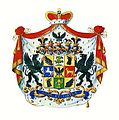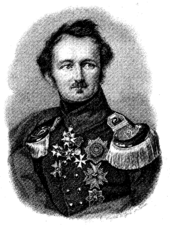Pückler
Pückler is the name of an old Silesian noble family .
After 1690 it split into two lines when two brothers were awarded an imperial count diploma. The older, Franconian line was able to acquire a share in the immediate imperial county Limpurg through marriage in 1737 and was accepted into the Franconian imperial counts ' college in 1740 , whereby they rose to the imperial estate and thus to the ruling high nobility .
The younger, Silesian line was able to acquire the rulership of Muskau through marriage after 1784 . However, it was a so-called " free class rule ", which did not involve any imperial class rule .
history
A verifiable ancestry has existed since the early 13th century. In Schwennicke's European Family Tables, Vol. IV, Nicolaus Pincerna, mentioned in 1306, can already be found in Generation V. The reliable family line begins with Henricus Pokeler (alias Pincerna = cupbearer or colloquially "Schenk"), who was recorded on May 22, 1365 Blumenthal in the Principality of Neisse buys. 1468 Nicolaus I. Pöckeler is mentioned in Bohemian documents; he acquires 1,488 Groditz in the Duchy of Opole and is considered the progenitor of the house Pückler, the 1655 rich baronial , 1690 gräflich was followed in an older, Frankish and a younger, Silesian split line.
In 1533 the neighboring Schedlau came into the possession of Niklas Pückler von Groditz, in 1570 a castle was built there, which was rebuilt several times in the following years . The property remained in the family until 1945. From 1572 the town of Falkenberg came into the possession of Kaspar von Pückler, who acquired it as property in 1581, creating the independent manor of Falkenberg. He brought the Reformation to the city and had the castle rebuilt in the Renaissance style. Falkenberg remained in the family until the middle of the 17th century.
Older Franconian line from 1690 counts, 1740 imperial counts
In 1676 Karl Franz Pückler, Baron von Groditz married Anna Cordula Freiin von Kresser, the heiress of Burgfarrnbach near Fürth . In 1737 his son, Christian Wilhelm Karl, married Countess Caroline Christiane von Löwenstein-Wertheim , who, as the granddaughter of the last Limpurg tavern, co-ruled Countess of Limpurg-Sontheim. This gave him the right to a share in the immediate imperial county of Limpurg and - as long as the inheritance had not yet taken place - as a personalist seat and vote in the Franconian Imperial Counts College (" introduciret zu Kitzingen 7 Apr. 1740" ). This made him and his legitimate descendants imperial counts.
In 1787, after the Waldeck-Limpurger inheritance dispute with the Sontheim- Gaildorf office , Christian Wilhelm Karl's son Friedrich Philipp Karl was assigned another part of the County of Limpurg, namely half of Gaildorf, Engelhofen, Seifertshofen and other properties around Ruppertshofen and Frickenhofen . In 1806 the county was mediatized and came under Bavarian and Württemberg sovereignty. The Counts of Pückler-Limpurg, like all previously sovereign houses, had special rights as so-called noblemen until the revolution in 1918 and belonged to the high nobility . In 1871, Count Curt von Pückler-Limpurg acquired Obersontheim Castle from the Württemberg crown , which remained in the family until 1901.
In 1950 Gottfried Wilhelm Maximilian and Adele Louise Mathilde von Pückler and Limpurg signed the founding deed of the Graf von Pückler and Limpurg charity foundation . Count Gottfried died in 1957, with the death of Count Siegfried in 1963 the male line of the Gaildorf branch of the Count's House of Pückler-Limpurg was extinguished.
Burgfarrnbach Castle
Younger Silesian Line, count from 1690
The Muskau rule, which was owned by the family from 1798 to 1845, was not part of the imperial class, it was part of the " Free Classes ". Count Hermann von Pückler-Muskau from this Silesian line was elevated to the Prussian prince's status in 1822 ( primogenitur ), whereby it was expressly noted that the free class rule of Muskau, unlike the free class rule of Oels, Trachenberg, Carolath and Pless, is not elevated to a principality. The prince's status died out in 1871, but his cousin Count Heinrich von Pückler inherited Branitz Palace and Park at Schönfeld , which remained in the family until 1945. After 1990, smaller parts of the Branitz property were bought back.
When the family of the Counts of Burghauß died out in 1885, Count Karl von Pückler entered the estate or majorate inheritance of Friedland in Upper Silesia . With a diploma dated July 15, 1887, he was granted the name and coat of arms association with those of the Counts of Burghauß, linked to the ownership of the Friedland Fideikommisses.
In 1885 the names and coats of arms were united with the Counts of Blankensee for Count Friedrich von Pückler (1852-1910). In 1901 the name was changed to Graf von Pückler and Blankensee , hereditary tied to the possession of the former Blankensee Fideikommisses Wugarten (now Ogardy ).
In 1909, Domanze Castle came to the Pückler family.
Schedlau Castle
Falkenberg Castle
Grave pyramid of Prince Hermann von Pückler-Muskau in Branitzer Park
Friedland Castle
coat of arms
The family coat of arms shows the head and neck of a black eagle in gold; on the helmet with black and gold covers a growing black eagle with open flight. According to Johann Siebmacher , the shield image shows a griffin head, not an eagle's head, according to old seals.
The " improved" Count's coat of arms from 1690 is quartered and covered with a golden heart shield , inside a crowned black eagle; 1 and 4 contain a black eagle's wing in gold, 2 and 3 the head and neck of an inward-facing crowned black eagle. On the shield 3 helmets with black and gold covers, on the right and left 3 each (black, gold and black) ostrich feathers, on the middle a crowned black eagle.
Coat of arms of Prince Hermann von Pückler-Muskau (* 1785, † 1871)
Well-known namesake (chronological)
- Prince Hermann von Pückler-Muskau (1785–1871), German landlord, traveler to the Orient , landscape artist and writer
- Friedrich Graf von Pückler (1786–1856), Prussian lieutenant general
- Wilhelm Graf von Pückler-Groditz (1790–1859), Prussian lieutenant general
- Erdmann III Graf von Pückler auf Schedlau (1792–1869), Prussian civil servant, agriculture minister and politician, member of the Prussian manor house
- Hermann Erdmann Konstantin Graf von Pückler-Groditz (1797-1892), lieutenant general, head stable master and court and house marshal of Kaiser Wilhelm I.
- Karl Graf von Pückler-Burghauß (1817–1899), Prussian manor owner and politician
- Erdmann IV Graf von Pückler auf Schedlau (1832–1888), Agriculture Council and member of the Prussian manor house
- Heinrich Graf von Pückler (1835–1897) at Schönfeld, 1871 heir to the Branitz Palace and Park from his deceased cousin of Prince von Pückler-Muskau and member of the German Reichstag
- Friedrich Graf von Pückler-Burghauss (1849–1920), general landscape director and member of the Prussian manor house
- Eduard Graf von Pückler (1853–1924), founder of the Christian community movement "St. Michael" in Berlin
- Carl von Pückler (1857–1943), German diplomat
- Walter von Pückler (1860–1924), German lawyer and anti-Semite
- August Graf von Pückler auf Branitz (1864–1937), Prussian civil servant and district president of Erfurt
- Siegfried Graf von Pückler-Limpurg (1871–1963), Dr. phil, German art historian and landowner
- Carl Friedrich Graf von Pückler-Burghauss (1886–1945), German politician ( NSDAP ), SS group leader and lieutenant general of the Waffen SS
- Mark G. von Pückler (* 1940), German lawyer and specialist author in the field of hunting and gun law
literature
- Meyers Konversationslexikon . Publishing house of the Bibliographisches Institut, Leipzig and Vienna, fourth edition, 1885–1892.
- Gothaischer Genealogischer Hofkalender . Gotha 1925.
- Gothaisches Genealogical pocket book of the count's houses. Gotha 1928.
- Gothaisches genealogical pocket book of the count's houses for the year 1863 , p.662ff
- Genealogical manual of the nobility . Nobility Lexicon. Volume XI, Volume 122 of the complete series, CA Starke Verlag , Limburg (Lahn) 2000, ISSN 0435-2408 .
- Detlev Schwennicke : European family tables NF. Volume IV, panels 65–66 (the first XV generations of the entire house), panels 67–68 the Counts of Pückler-Limburg, panels 69–73 the Counts Pückler-Muskau zu Branitz (with the only prince), Schedlau, Groditz, Burghauss , Blankensee etc.
Web links
- Graf von Pückler and Limpurg'sche Charity Foundation
- Website Schloss Burgfarrnbach - history of the Pückler-Limpurg counts
- The Principality of Opole
Individual evidence
- ↑ a b Genealogical manual of the nobility. Nobility Lexicon. Volume XI, Volume 122 of the Complete Series, pp. 68-70.
- ↑ Codex. diploma. Siles. 14, p. 75
- ↑ Neißer Lagerbuch, fol. 8 b, in the StArchiv Breslau, Rep. 31 F, Neisse III, 21 A
- ^ European genealogical handbook - Christian Wilhelmus Carol , 1754
- ↑ Adelslexikon Volume XVII (Supplements), Volume 144 of the complete series, Limburg (Lahn) 2008, pp. 96–97.
- ^ "[...] The heads in the W. of the Counts v. Oppersdorf and v. According to old seals, Pückler are also griffin (not eagle) heads, as is the one in the coat of arms of the city of Stettin . ”- Johann Siebmacher : Greif (panel XXII. Fig. 15-21)
- ^ Pückler, Carl Graf von












